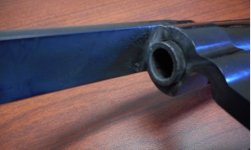You are using an out of date browser. It may not display this or other websites correctly.
You should upgrade or use an alternative browser.
You should upgrade or use an alternative browser.
Cracked forcing cone? (see pic)
- Thread starter Carmady
- Start date
I can't tell; more info on the gun and ammo involved would help. Example: A medium frame .38/357 (Model 19) with very hot loads of jacketed bullets is almost a recipe for a cracked forcing cone. A heavy frame (Model 28) with mild loads would be extremely unlikely to see any damage like that.
Jim
Jim
FrankenMauser
New member
Very dirty.
That's the best observation I can make with that photo.
Please clean it and try again.
That's the best observation I can make with that photo.
Please clean it and try again.
It's a S&W 13 on GunBroker, don't know anything about the ammo used.
When the picture is enlarged it's easier (for me) to see the flat spot they machine around 6:00, and I thought it was a crack. Something looks iffy around 12:00-1:00, but that might just be lead or something.
When the picture is enlarged it's easier (for me) to see the flat spot they machine around 6:00, and I thought it was a crack. Something looks iffy around 12:00-1:00, but that might just be lead or something.
Model12Win
Moderator
Very dirty.
That's the best observation I can make with that photo.
Please clean it and try again.
True dat.
You need to clean that bbl brotha.
Driftwood Johnson
New member
Sorry, you have to provide a much better photo.
Something with better lighting that is in focus.
This is what a typical cracked forcing cone looks like. Notice it runs right down the center of the forcing cone, right down the center of the relief cut for the cylinder gas ring. This is the spot where the forcing cone is the thinnest.

Something with better lighting that is in focus.
This is what a typical cracked forcing cone looks like. Notice it runs right down the center of the forcing cone, right down the center of the relief cut for the cylinder gas ring. This is the spot where the forcing cone is the thinnest.

Last edited:
That's the first I've heard of lead causing throat cracking. How many have you cracked? I've shot predominantly lead alloy bullets through my Smiths, with loads ranging from mild to wild, for over 50 years with no cracking. I'd be interested in your source of that bit of information. Thanks in advance, RodI've cracked my share of forcing cones on the K-Frame S&Ws. Caused by using a lot of lead ammo.
Last edited:
The Kingfish
New member
So can a cracked forcing cone be repaired?
Or does the gun become a paper weight?
Or does the gun become a paper weight?
Jim Watson
New member
Repaired by replacing the barrel.
Jim Watson
New member
Could do. Would it work to cut the barrel tenon off flush with the inside of the frame before trying to unscrew? There are some other machinists' tricks that could salvage the frame.
But - - if you can't shoot it or try to replace the barrel isn't that the same thing as fini?Rarely, continuing to shoot a revolver with a cracked forcing cone or even an attempt to remove the barrel will crack the frame and that, boys and girls, is finis for the gun.
Poor photo, indeed.
However, it is reported that cracked or eroded/pitted/damaged forcing cones related from the use of smaller grain projectiles (example, 110 - 125 grain in 357) being pushed with heavier charges of slower burning powders. However, I've also read reports of forcing cone damage even with the use of heavier projectiles as well.
However, it is reported that cracked or eroded/pitted/damaged forcing cones related from the use of smaller grain projectiles (example, 110 - 125 grain in 357) being pushed with heavier charges of slower burning powders. However, I've also read reports of forcing cone damage even with the use of heavier projectiles as well.
I would resolve my doubt about that crack by forgetting about that Model 13 and looking for one with a better looking forcing cone. If that's the seller's photo you are showing us, why do you suppose he left it dirty when posting it for sale? Perhaps to cover up a crack? I would look elsewhere for a nicer gun.

